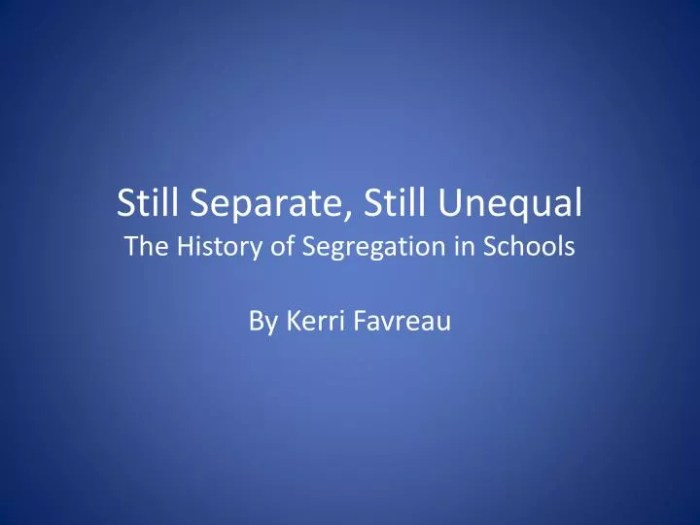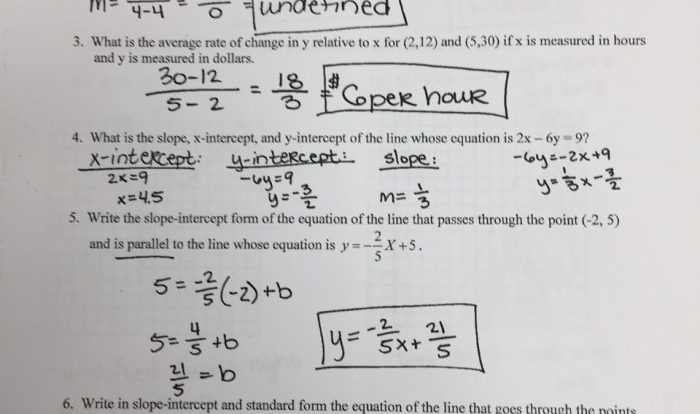Still separate still unequal jonathan kozol – Jonathan Kozol’s groundbreaking work, “Still Separate, Still Unequal,” exposes the persistent inequalities that continue to plague the American education system, despite decades of legal efforts to end segregation. This seminal book provides a comprehensive analysis of the historical, socioeconomic, and political factors that have contributed to the enduring disparities in educational opportunities and outcomes between different schools and communities.
Kozol’s meticulous research and compelling narrative provide a sobering account of the challenges faced by underserved students, particularly those from low-income and minority backgrounds. He argues that the legacy of segregation has created a system of separate and unequal schools, where students from marginalized communities are denied the same access to quality education as their more affluent peers.
Historical Context

The legacy of segregation in the United States has had a profound impact on American education. Legal efforts to end segregation, such as the Brown v. Board of Education decision in 1954, have failed to fully dismantle the system, and segregation persists in schools today.
Forms of School Segregation
- Residential segregation: The separation of different racial and ethnic groups into different neighborhoods, which leads to segregated schools.
- School district gerrymandering: The manipulation of school district boundaries to create segregated schools.
- Tracking and ability grouping: The practice of assigning students to different academic tracks or classes based on their perceived abilities, which often leads to segregation by race and class.
Educational Disparities

Educational inequality in the United States is a persistent problem. Schools in low-income communities and communities of color are often underfunded and understaffed, and students in these schools have less access to resources and opportunities than their peers in more affluent communities.
Disparities in Funding
- Schools in low-income communities receive less funding per student than schools in affluent communities.
- This funding gap has a significant impact on the quality of education that students receive.
Disparities in Resources
- Schools in low-income communities often have fewer teachers, counselors, and other support staff.
- They also have less access to technology, textbooks, and other resources.
Socioeconomic Factors
Socioeconomic factors, such as poverty and housing instability, play a major role in educational inequality. Students who live in poverty are more likely to attend underfunded schools and have less access to resources and opportunities than their more affluent peers.
The Role of Race and Class
- Race and class are closely linked to educational opportunities and outcomes.
- Students of color and students from low-income families are more likely to attend segregated schools and have less access to resources than their white and affluent peers.
School Segregation
School segregation is the separation of students into different schools based on their race or socioeconomic status. Segregation has a negative impact on student achievement and social mobility.
Causes of School Segregation
- Residential segregation: The separation of different racial and ethnic groups into different neighborhoods, which leads to segregated schools.
- School district gerrymandering: The manipulation of school district boundaries to create segregated schools.
- Tracking and ability grouping: The practice of assigning students to different academic tracks or classes based on their perceived abilities, which often leads to segregation by race and class.
Consequences of School Segregation
- Segregated schools have less funding and resources than non-segregated schools.
- Students in segregated schools are more likely to be exposed to violence and crime.
- Segregation limits students’ opportunities for social mobility.
Educational Policies: Still Separate Still Unequal Jonathan Kozol
Educational policies play a role in perpetuating or addressing educational inequality. Some policies, such as school choice and affirmative action, have been designed to promote educational equity.
Effectiveness of Educational Policies, Still separate still unequal jonathan kozol
- School choice: School choice policies allow parents to choose which school their child attends, regardless of their neighborhood.
- Affirmative action: Affirmative action policies give preference to students from underrepresented groups in admissions and hiring.
- The effectiveness of these policies in promoting educational equity is debated.
Community Involvement

Community involvement is essential for addressing educational inequality. Communities can work together to improve schools and provide students with the support they need to succeed.
Successful Community-Based Initiatives
- Parent involvement: Parents can be involved in their children’s education by volunteering in schools, attending school events, and advocating for policies that support education.
- Community schools: Community schools provide a range of services to students and families, including after-school programs, health care, and job training.
- Mentoring programs: Mentoring programs provide students with support and guidance from adults who care about their success.
Recommendations for Change

There are a number of key recommendations that can be made to address educational inequality and promote educational equity.
Recommendations
- Increase funding for schools in low-income communities.
- Provide more resources to schools in low-income communities, such as teachers, counselors, and technology.
- End school segregation.
- Implement policies that promote educational equity, such as school choice and affirmative action.
- Increase community involvement in schools.
Questions and Answers
What is the main argument of “Still Separate, Still Unequal”?
Kozol argues that the American education system remains deeply segregated and unequal, despite legal efforts to end segregation. He identifies socioeconomic factors, such as poverty and housing instability, as key contributors to these disparities.
What are some of the key recommendations made by Kozol?
Kozol calls for increased investment in early childhood education, expanded access to affordable housing, and comprehensive support for struggling schools.
How does Kozol’s work contribute to the understanding of educational inequality?
Kozol’s meticulous research and compelling narrative provide a comprehensive analysis of the historical, socioeconomic, and political factors that have contributed to the enduring disparities in educational opportunities and outcomes between different schools and communities.

